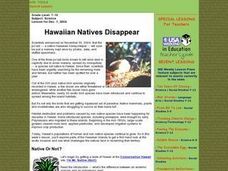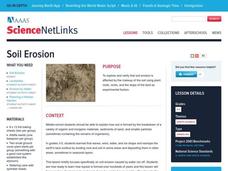Curated OER
Tobacco: Exploring Tobacco Culture
Eighth graders are introduced to the tobacco planting process. Using primary sources, they identify the steps necessary to grow the popular crop. They create a flow map to organize the process graphically. They discuss the...
Curated OER
Kernel Count!
Here is an impressive and thorough lesson on estimation. Young mathematicians estimate how many kernels of popcorn can fit in a tablespoon, then how many tablespoons of kernels can fit in a baby food jar. The popcorn is then popped. All...
Curated OER
Agriculture: It Doesn't Just Happen
After reading an informational text on the Agricultural Research Service, learners research the role of the ARS in Oklahoma. Using reputable online sources, they label a map of the state with relevant areas. Researchers focus on one of...
Curated OER
Sorting
Students experience sorting. In this organization lesson, students play a computer sorting game called "Flood Game" on the "Between the Lions" website. Students visit a library and observe and discuss book organization. Students work in...
Tennessee State Museum
An Emancipation Proclamation Map Lesson
Did the Emancipation Proclamation free all slaves during the Civil War? Why was it written, and what were its immediate and long-term effects? After reading primary source materials, constructing political maps representing information...
Curated OER
Soil Porosity, Moisture Content, pH, and Density
This lab activity does not have to be done with AP environmental scientists. It can also be done with middle to high school earth scientists. The procedures aren't complex. Learners determine the density of dry and wet sand in order to...
Curated OER
El Salvador: How Can My Breakfast Harm the Birds?
Sixth graders explore how their food choices can have an impact on the rain forests. They examine coffee farming and how their techniques can harm birds in the rain forest. Students design two farms with sustainability of bird habits in...
Tennessee State Museum
Deciphering the Document: Unlocking the Meaning of the Emancipation Proclamation
Help your learners truly understand the Emancipation Proclamation by asking them the put it into their own words. After reading the document out loud to the class, and briefly discussing the legal language, split your class into small...
Curated OER
It All Starts With a Seed
Students use laboratory equipment safely. They identify structures in a seed. They distinguish between monocots and dicots. They search for information using the computer.
Curated OER
Web Page Creation
Students complete a unit of lessons on web pages and web page creation. They conduct Internet research, identify the characteristics of effective and ineffective websites, construct a glossary of terms, and develop three web pages.
Curated OER
Wheat Kernels Bar Graph
Third graders create a bar graph to record how many kernels were in a wheat stalk. They write in math journals two questions from interpreting the graph. They solve math problems from other students.
Curated OER
Popcorn Geography
Students use kernels to create a "Top Corn-Producing States" map or graph. They read and round off numbers. Students identify on a U.S. outline map the location of corn-growing states. They create a visual (map or graph) illustration...
Curated OER
This Land Is Our Land
Students explore land use. In this land lesson, students examine the use of land and land records. They create a diagram of a specified piece of land and determine the area of the land. Students discuss their findings.
Curated OER
Hawaiian Natives Disappear
Students explore parts of the Hawaiian Islands to get a examine the exotic invasion, and see what challenges the natives face in reclaiming their territory. They identify the changes in the environment that have been the hardest on the...
Curated OER
American Indians of the Local Region
Students describe the American Indian nations in their local region long ago and in recent past. They research religious beliefs, customs, and various folklore traditions.
Curated OER
Symbols and Landmarks
Third graders study American national holidays, symbols, songs and landmarks. They appreciate the meaning and significance of our nation's ideals of liberty, justice and equality.
Curated OER
Soil Erosion
Young scholars examine how erosion is affected by the composition of the soil and the slope of the land. They look at plant roots, rocks and land slope as experimental factors. They complete the associated worksheets before discussing...
Global Oneness Project
Living with Less Water
Did you know that California produces two thirds of the fruits and nuts consumed in the United States? That it produces almost one third of the vegetables? Did you know that scientists warn that California is facing the onset of a...
Curated OER
World Hunger - Causes And Solutions
An online Sim City type game from the BBC website guides young scholars to complete a World Food Programme mission. They investigate the causes and of hunger in different parts of the world and then research a particular region's hunger...
Curated OER
Will You Pick My Cotton?
Use this cross-curricular history lesson to work on your students' informational writing skills. After listening to songs and stories related to Sultana, they engage in a several activities to boost their understanding of slavery and...
Curated OER
Filling Up-Gasoline
In this fuel sources worksheet, students calculate the E85 alternative fuel costs per gallon compared to the cost of gasoline. Students complete a table to show the comparison prices. They create a triple line graph to show the...
Curated OER
The Pre-Civil War Era (1815–1850)
In this online interactive U.S. history worksheet, students respond to 9 short answer and essay questions about 19th century America. Students may check some of their answers on the interactive worksheet.
American Museum of Natural History
Bio-Benefits
Kick-start a discussion of the importance of biodiversity with a colorful resource that touts the benefits of maintaining healthy ecosystems. The images stress the interdependence of all the elements of an ecosystem.
Curated OER
The Four Revolutions of the 18th Century: Industrial, Demographic, Agricultural, and French
In need of lecture notes that will help you and your learners? Here you'll find a presentation that covers four major revolutions occurring in the 1800's; The French Revolution, The Industrial Revolution, the agricultural revolution, and...
Other popular searches
- Crop Production Inputs
- Crop Production Slave
- Crop Production Usa Map
- Incas Crop Production
- Crop Production Usa
- Cereal Crop Production

























